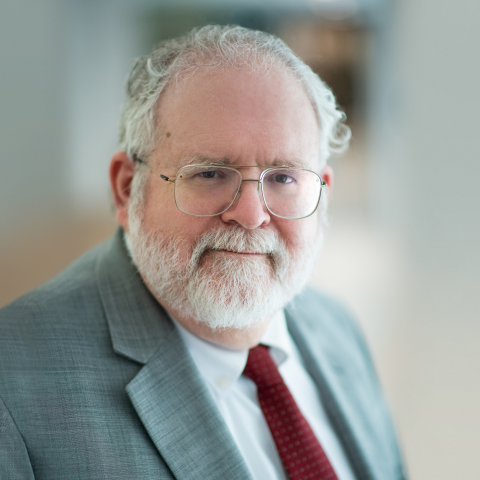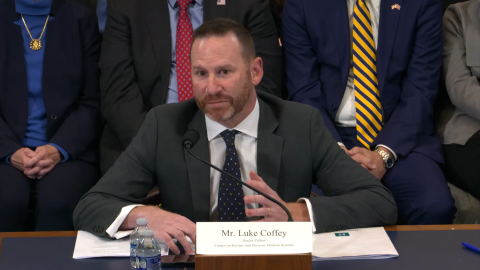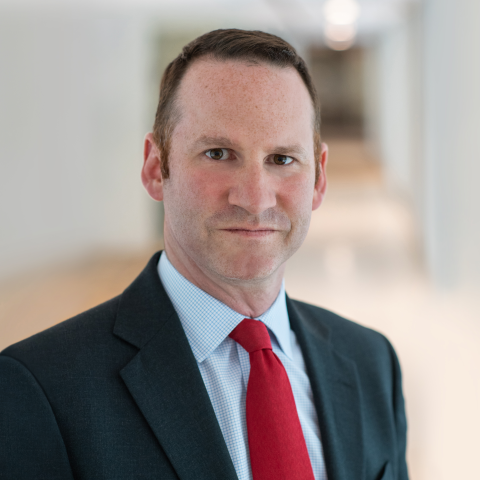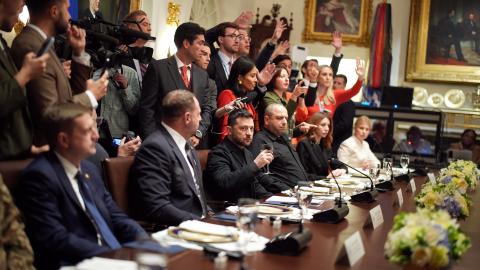
In-person attendance is by invitation only.
Event will also air live on this page.
Inquiries: [email protected]
Big Ideas for America’s New National Security Team

In-person attendance is by invitation only.
Event will also air live on this page.
Inquiries: [email protected]
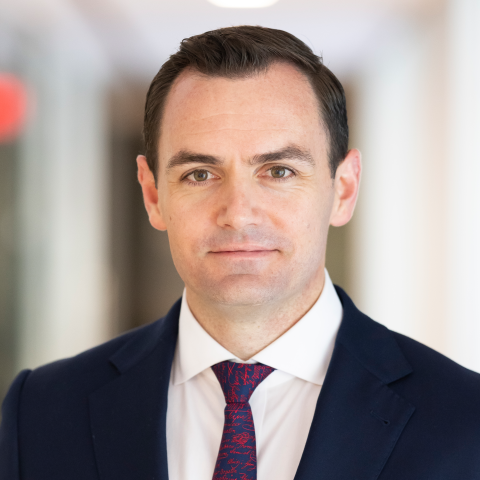
Distinguished Fellow
Mike Gallagher is a distinguished fellow at Hudson Institute.

Senior Fellow
Nadia Schadlow is a senior fellow at Hudson Institute and a co-chair of the Hamilton Commission on Securing America’s National Security Innovation Base.

Senior Fellow and Director, Center on Europe and Eurasia
Peter Rough is a senior fellow and director of the Center on Europe and Eurasia at Hudson Institute.
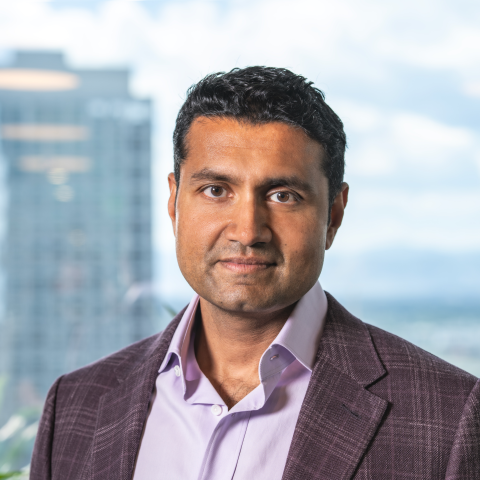
Trustee
Shyam Sankar is a trustee at Hudson Institute and chief technology officer and executive vice president of Palantir Technologies.
The next four years of American foreign policy will be crucial. From Afghanistan to Ukraine to Israel, the Biden administration failed to fulfill its commitments, and China, Russia, Iran, and North Korea have seized on this opportunity to increase their collaboration. America’s global allies and partners have looked on nervously as this axis of authoritarians developed into a major threat to the American-led world order.
Distinguished Fellow Mike Gallagher will join Palantir Chief Technology Officer Shyam Sankar and Senior Fellows Peter Rough and Nadia Schadlow to discuss what to expect from the second Trump administration and how Washington can change course by returning to hard-power principles and reasserting American dominance on the world stage.
Event Transcript
This transcription is automatically generated and edited lightly for accuracy. Please excuse any errors.
Peter Rough:
All right, good afternoon everyone, and welcome to Hudson Institute. My name is Peter Rough, I’m a senior fellow here and director of the Center on Europe and Eurasia. And today I have the great pleasure of being in the moderating chair for the first public event of our newest trustee, lucky number 13, the 13th employee at Palantir, CTO Shyam Sankar. Welcome to Hudson Institute. That deserves a round of applause, I think, right off the bat.
Shyam envisioned the role of forward deployed engineer at Palantir, pioneering the company’s definitional engineering model. We’ll see what sort of reforms he has in store for our senior fellows and research fellows at Hudson, and he holds a Bachelor from Cornell and a Master’s from Stanford. He recently published The Defense Reformation. It made me a bit nervous as a Roman Catholic when you’re quoting Martin Luther and you had 18 reforms. Thought you might get to 95 treaties by the end, but excellent, and we’ll talk about that in a minute.
In the middle is one of our newest colleagues, Mike Gallagher, a distinguished fellow and head of defense at Palantir, former Congressman, Marine, and led the House Committee on competition with the CCP, has a PhD in international relations, multiple Master’s degree. A man of letters, as we like to say, and an avid Green Bay Packers fan. I think he’s prouder of that than anything else. Mike, thanks for being here.
And last but certainly not least, Nadia Schadlow, senior fellow here at Hudson, previously Deputy National Security Advisor for Strategy. She led the drafting and shepherded the 2017 National Security Strategy through government, a BA in government from Cornell and a PhD from Hopkins. Nadia is one of the wisest voices in Washington, and it’s a great delight to have these three colleagues here to talk about transition, which we are in the middle of, and what the next Congress and administration might have in store.
So Shyam, I know you have thoughts about what they should have in store, so perhaps you could preview for those watching at home and those of us in the audience who haven’t had a chance to pore over your defense reformation work yet, what you think is ailing and amiss and where you think maybe we should be heading in the defense, foreign policy, national security space.
Shyam Sankar:
Well, at the broadest level, I think we’ve forgotten about the primacy of winning. We’ve created this system, all this process, we think about reforming the defense acquisition system. Is our goal to fix the system or to win? And I think if your goal is the latter, you come to a very different set of conclusions. You look at the world today, and we are in an undeclared state of emergency. We have North Korean generals getting wounded in Ukraine, we’ve had a pogrom in Israel, we have crazy tension, unprecedented Phase Zero gray zone operations in the South China Sea. Counterfactually, what more would have to happen for us to say that we are on the precipice of World War III, and what do we need to do to deter it?
And then you could say, “Look how many trillions we’ve spent on national security since the end of the Cold War. How did we lose deterrence? What happened to Pax Americana?” And when I look at the industrial base, I see that we’ve lost our way. We once had an American industrial base. Chrysler used to build cars and missiles. Ford built satellites until 1990. General Mills, the cereal company, built torpedoes. And today we live in a very different world. We have a defense industrial base, not an American industrial base. We’ve put these folks on the Galapagos Islands, and it is a great schism between commercial and defense innovation. We could build the anti-aircraft gun in 15 minutes because Pontiac could leverage everything they knew about building cars to enhance the lethality and national security of our nation. It used to take the US Army three and a half hours. We’ve lost the ability to do that. In certain pockets we’ve got it again. Look at SpaceX. SpaceX has driven a 1000X price performance increase in launch costs, from roughly $25,000 a kilogram down to $10 to $20 a kilogram. And maybe we got that because Elon is obsessed with getting to Mars, but thank God he is. If you’re only solving the national security problem, you’re going to miss the bigger picture. It is that prosperity that powers this, and I think we’re at the dawn of being able to fix this.
And to put that in numbers, at the fall of the Berlin Wall, only 6 percent of major weapons system spending went to defense specialists, folks like the primes. Today that number is 86 percent. So how do we get back? I think the reformation is about getting back to an American industrial base where the economy is invested not only in prosperity, but also freedom. We’re able to leverage commercial innovation to enhance our national security, which unfortunately is exactly what the Chinese are doing. Chinese primes only derive 27 percent of their revenue from the PLA. The rest is from us as patsies buying cheap crap on Amazon, subsidizing lethality against US service members.
Peter Rough:
Well, that seems to be one of the central themes of your piece and of some of your public commentary, that we basically need to inject the market forces of commercial activity into the monopsony power of public sector procurement. Can you just expand on that for me?
Shyam Sankar:
That’s exactly it. I think monopsony is the root of what ails us. At some very fundamental level, you either believe in the free market or you don’t. And everyone, including the Chinese and the Russians, have given up on communism except for seemingly Cuba and the DOD. We have five-year centralized plans, we have two-year POM process. As Bill Greenwald has called it, it’s a centrally unplanned process. And there’s no world in which we’re going to be better commies than the Commies. So we should lean into what has actually generated all of this US prosperity. I love Mario Draghi’s scathing report on the state of European competitiveness. In the last 50 years, Europe has created zero companies from scratch worth more than $100 billion dollars. In the last 50 years, we’ve created all of our trillion-dollar companies from scratch. That’s incredible.
And so how do we start to approximate market forces in government? And we used to do this. When we were building ICBMs, the services were competing against each other. We didn’t have a joint program office, we didn’t ask one service to take the lead. Every service was competing to go do that. When we were building submarine-launched ballistic missiles, we had four concurrent competing programs under Admiral Raborn, and we got there cheaper and faster because of it. So we spend way too much time thinking about is there enough competition in the industrial base? And we’ve lost the plot. There actually needs to be way more competition inside of government itself to deliver this. And the aesthetic of, “Wouldn’t that be duplicative? Wouldn’t that be wasteful? Shouldn’t we have a unitary effort?” That is communism. That’s what we need to get away from.
Nadia Schadlow:
Peter, could I make a comment about that?
Peter Rough:
You may.
Nadia Schadlow:
I think the conditions to do all that are right now with the new administration, because the underlying conditions of what you need to achieve what Shyam mentioned are things like regulatory reform, economic and trade policies that are supportive. And this doesn’t necessarily cost money by the government, but the government needs to create an environment to incentivize the kinds of changes. So I think what the previous administration got wrong is that they were not allowing these conditions of reduced regulations, energy diversification and energy strength and dominance, because you need energy to supply the manufacturing facilities. And I think we’ll be in a good position to do a lot of that with the new administration going in.
Peter Rough:
In addition to the other bullet points in your resume that I mentioned, Congressman Gallagher is also now a regular contributor to the Wall Street Journal, and just last week you had a pretty forward-looking piece, I thought ,about all the different components of DOD reform that you think should be in the offing. Can you sketch that out for the one or two out there that don’t religiously read your column?
Mike Gallagher:
Yeah, who are those people? Why did they get invited to this event?
Nadia Schadlow:
They’re five years old.
Mike Gallagher:
That’s right. Well, first of all, let me submit a complaint for the record. I thought when I left Congress and joined Palantir that in addition to running the defense portion of the business, I was going to be the defense intellectual at the company. That’s sort of what I did in a previous life. And little did I know that Shyam already had that territory covered. And then I made the mistake of inviting Shyam to a Hudson event and everybody fell in love with Shyam, and now Shyam’s got the Hudson thing. It wasn’t enough that you had to start one of the most successful-
Peter Rough:
Yeah, let me ask Shyam a few questions.
Mike Gallagher:
Yeah. What else can you take away from me? But no, it’s really exciting to be able to just be Shyam’s hype man, because as you’ve already seen, he’s one of the most brilliant human beings alive. And he’s not technically my boss, so I’m not paid to say that.
But okay, so if I look at the hardest problems that the next Secretary of Defense has to find a way to solve, or at least improve, right? And make no mistake, I think of the many jobs that are very difficult in an administration, I might submit that being Secretary of Defense is the hardest because it is the biggest bureaucracy, the inertia is probably the strongest, and figuring out a way to manage your relationship with the President, have service secretaries that you trust, and actually pursue a reform agenda is something very, very few Secretaries of Defense have done successfully.
And if you read the biographies of those who have been successful or somewhat successful, from Bob Gates to a great Wisconsinite, Mel Laird, one thing becomes apparent, which is that unless the Secretary himself, with the backing of the President, prioritizes a thing, or at most three things, and wakes up every single day bending the bureaucracy to his will, those things will not get done.
So the question is, what are the most important things that will help prevent World War III? In my opinion, as I’ve said multiple times at Hudson, the priority theater is the Indo-Pacific. Our greatest enemy is the Chinese Communist Party. Therefore, the priority force has to be the United States Navy, or more specifically the Navy Marine Corps team. That doesn’t take anything away from the Army or the Air Force, which have a significant role to play in the fight. But the hardest challenge, in my opinion, is to find a way to revitalize our broken shipbuilding industrial base, and we are behind schedule on almost everything. We can’t keep ships on the water, the repair numbers are terrible, our ability to fulfill our AUKUS commitments is in jeopardy right now because we can’t build enough subs. So the signature defense initiative of the Biden administration, which I was very supportive of, is slowly dying because of our inability to build ships quickly.
So fixing the shipbuilding industrial base, and I’m happy to elaborate on what’s necessary for that, finding a way to replenish our arsenal of deterrents, i.e all the critical munitions and long-range precision fires that can hold Chinese ships at risk, thereby reversing the logic of what they’ve done to us in the Indo-Pacific, building a rocket force designed to keep our ships out of the fight. We can do that to them if we provide a consistent demand signal, if we get innovative, if we put advanced energetics, as Nadia has written about more eloquently than anybody else, in those weapons systems.
And then finally, in order to generate the money that is necessary, if you assume that we’re not going to get a massive defense buildup, and I for one would argue for a massive defense buildup, but let’s assume we’re not going to get one, then you’ve got to get creative with reforming the supporting establishment, the fourth estate.
And as difficult and as politically problematic as those efforts can be, I think there is a massive opportunity to shrink the largest branch of the military, which is not the Army, but rather the defense civilian workforce. The entire acquisition workforce is bigger than the United States Marine Corps. The Pentagon owns a bunch of valuable property, golf courses, hotels, that it does not need to own. You can recycle those assets or you can take the money, to quote another Bill Greenwald idea, that the Pentagon gets given to it, appropriated to it every single year, but is not spent at the end of the year, and therefore goes back into the Treasury and sits in abeyance for five years and then disappears or is laundered for non-defense purposes, give the Pentagon the flexibility that many other agencies have to repurpose that money for, let’s say, great commercial software or long-range precision fires or some subset of things that you can actually deliver within the next two years to enhance lethality. Because if it doesn’t happen in the next two years to enhance lethality because if it doesn’t happen in the next two years, in some ways it doesn’t count in terms of my calculus for preventing World War III.
Peter Rough:
You mentioned that you’d like to, or you’d be willing to elaborate on your ideas for the shipbuilding base. Can you do that for just a second?
Mike Gallagher:
Yeah. So basically, right now the way requirements for ships are generated, there’s technical specifications that are generated independently from some of the other requirements. The Navy used to operate under a board model where there was a set of stakeholders with a chair who was empowered to make decisions to better harmonize all the requirements. So you didn’t have things that don’t add up or don’t make sense, or you didn’t have NAVSEA with the ability to pop in at the last second and change requirements. And therefore, a shipyard trying to build a ship is constantly operating with the rug being pulled out from under it. So that’s one thing.
The other thing I think the Navy could adopt a version of the Rapid Capabilities Office that other services have in order to expedite the delivery of key systems, particularly autonomous systems, medium and large, autonomous surface vehicles, underwater vehicles, and some autonomous aerial vehicles as well.
What else would make sense? Let’s get a Secretary of Defense who actually believes in sea power, and can make a case to the American people for why we need a bigger fleet, and have one coherent shipbuilding plan as opposed to five different plans that don’t talk to each other and just confuse Congress. And by the way, Congress has passed into law the goal of having a 355-ship fleet as soon as practically possible. That was passed into law in 2018 or 2017 when I was a freshman member of Congress. The only problem is our fleet is getting smaller. We’re set to bottom out in 2027, the year that Xi Jinping has set for having his military ready to take Taiwan by force if necessary. We’re headed on the wrong trajectory in part because we don’t have that consistent demand signal and a Secretary of the Navy and Secretary of Defense who’s making the case for why a bigger navy and a more lethal Navy is necessary in order to prevent war.
Peter Rough:
So Mike mentioned that he’s partial to Nadia’s work on energetics. I confess, I’ve never told Nadia this, my favorite piece of yours of all time, I don’t remember where you wrote this, was the one where you said everything’s already been essentially laid out. Everything’s been studied. We need to actually, rather than launch a new Blue Ribbon commission or have a new white paper churned out by various sundry think tanks, begin the implementation of these things. You mentioned that the moment is propitious, that perhaps now with the new government, it’s time for us to move out. What are some of these ideas that you think are really, the time is ripe and we might actually get to implementation?
Nadia Schadlow:
Well, it’s funny that you say that because I was going to have the temerity to edit one phrase that Mike had said, which was find a way. And I was going to say, “No, Mike. We know the way.” All in this room, so many of us, everyone working on these issues, Hudson, other think tanks too, we know the way now. So the key for this administration, and as you mentioned in your column this week, you mentioned, I forget one of the reform reports from-
Peter Rough:
You didn’t read it yet?
Nadia Schadlow:
Which report was that?
Mike Gallagher:
The 2015 Defense Business Board Report.
Nadia Schadlow:
Right. There are so many out there, and actually, I say that with admiration for a lot of the reports, they’re good. There’s a lot of good and useful information. The problem is it hasn’t been implemented. So the use of other transaction authorities, I’m not an expert on these issues. There are others in the room are much more, and Bill, who you mentioned, and certainly Shyam and Mike, but this administration needs to come in, the Secretary of Defense, and just use them and take the risk. And I do think a lot of the officials now being vetted and who will be out there and likely to take places, they’re risk takers. They will take the risk. So it’s the job of institutes like Hudson to come up literally with the lists of the things that need to be done, not new, not doing more studies necessarily, but drawing on the work we’ve already done.
How do you build the hedging force that Brian Clark and Dan Patt and my colleagues have discussed? How do you ensure, and I’m asking how, but how do you actually take some of the recommendations in the Energetics report to start to build more facilities, ensure that the government actually buys these facilities, reduce permitting regulations so that you can build them in communities? Not saying next door to your child’s playground, but there are places in this country where you can build facilities. How you can use AI more effectively to come up with the chemical compounds that you need for these energetic materials. There’s a lot going on. We have a lot of strengths in the R&D community in this area. It’s really about scaling the innovation and scaling it to actual manufacturing. And we know how to do that. The key will be to ensure that as this administration focuses on Doge and on the cutting, it is very, very important.
But cutting, as Shyam and I were speaking just before the panel, cutting is not the same thing as shaping outcomes. You can cut, you need to cut, but you also, at the same, time need to have an operational concept for how you want to get to where you want to be. And cutting is not enough. That’s maybe a part of the plan, but it’s not the actual concept of how you have to shape the changes. You can reduce the acquisition core and then test the . . . Actually, one way to do it would be to test the acquisition core on their knowledge of these unused authorities, many of which I’ve learned about from Mike. Actually test them like a multiple choice test. Which ones exist? Those who don’t pass probably are not the ones that should stay. And actually, that’s very practical. It’s very doable. Maybe you give them a chance in a few months to study up and then start to use them. You start to promote based on how many times these alternative authorities are used, and you’ll start to see speed become a factor too.
Mike Gallagher:
Okay. This is a Thornberry idea that I was never able to put in practice. Congress should have something akin to a quarterly thunderdome, where it brings the services in or all the relevant officials or the right PMs and says, “Yes. Okay. How many times have you used this authority? How many times have you used the unique hiring authority that Congress has given you to take someone like Shyam and make him a colonel or a general or an ensign?” Hey, the tip of the spear man. Maybe a lance corporal in the Marine Corps. So my only point to add on to your brilliant point is that Congress can play a role in forcing the administration to change.
Shyam Sankar:
And I think that’s important because we don’t need more authorities. When people talk about acquisition reform, it’s like we need to stop talking about what authorities we need to give. It’s all there. We need to make sure it’s employed, that it’s used. And a lot of that starts, maybe you wouldn’t expect a technologist to say this, but it starts with leadership. It starts with putting the right people in the roles who have the risk appetite and are going to lead this thing, and not just trying to promulgate things down through a bureaucracy. You have to reshape the organization to get the outcomes that you want.
Peter Rough:
That was actually an interesting point in your defense Reformation paper, the changes in personnel, the promotions versus what they once were, where you actually keep people in leadership positions over the lifetime of projects so that they can succeed because they’re driving change versus not. Can you expand on that, just for a minute?
Shyam Sankar:
Yeah. I think the person is the program, we call it the F-16, but maybe we should call it John Boyd’s plane. What is the counterfactual for the SR-71 or the U-2, which I think was built in like 13 or 15 months, we still fly it today, Kelly Johnson. And there are really exceptional humans. We believe in that as America. We call them the founding father for a reason. Whether you’re a founder of a company or a founder of a program, that deep investment of unique humans, that individualism is clearly what works. I don’t think there’s a great counterfactual of Apple without Steve Jobs. And so when you find that chemistry, when it’s going to take a Rickover to build the nuclear navy over 30 years, and I think Congress has a role to play in making sure that typically these very creative people are difficult, and they’re going to be rejected and chewed up by the system. They need to protect those people and keep them in place and create the room for people . . .
Your career is not some bingo card to go fill out by constantly being shifted around to say you’ve had these various experiences. Your impact is going to come from your superpowers. How do you get people into that zone and then keep the bet on them until you deliver?
And then the pushback I usually get with this is like, “Well, in the end, Rickover had to be fired.” Exactly. That’s fine. I still think that is playing out the way it should. Ed Hall was a notoriously difficult individual, actually pulled a machine gun on a bunch of British mechanics who were not willing to fix planes properly during World War II. But Shriver kept him in place. Edward Hall all built the Minuteman. Shriver kept him in place. No one wanted to work with him. The second the Minuteman worked, he fired him. And that’s how it should work.
Nadia Schadlow:
And this is an aside, but it was a key issue during the Counterinsurgencies in Iraq and Afghanistan, a key issue was that just as people would start to get to know a particular region and the complexity of the region, they would be pulled out. And it was stupid and it had a serious impact, a negative impact on the course of both wars.
Mike Gallagher:
Thus we fought, what was the quote? 17 different-
Nadia Schadlow:
Six-
Mike Gallagher:
Yeah, it says.
Nadia Schadlow:
17 different cups of tea. Every year-
Mike Gallagher:
Yeah, yeah. Exactly. Exactly.
Nadia Schadlow:
You have a new cup of tea with a new-
Mike Gallagher:
Shyam, is there an analog . . . So this whole essay about founder mode versus manager mode went wild in Silicon Valley and in the tech world. I think there’s an analog in DOD that’s like if you truly believed that we were headed towards a confrontation with China in 2027 or sooner, or sometime within the next five years, you would be doing things profoundly differently. I salute the CNO for her NAP plan, which the theme is 2027, 2027, 2027. But has the entire Pentagon embraced that ethos? There’s a wartime versus peacetime, founder mode versus manager mode that the Pentagon hasn’t embraced.
Peter Rough:
Wait until you look under the hood of our fellow European militaries.
Mike Gallagher:
Yeah.
Peter Rough:
Which are supposedly preparing for war with Russia, but are eons away from actually being able to do so.
Mike Gallagher:
Yeah.
Shyam Sankar:
I think there’s a great analog to that. So much of this is that we’re just not focused on the problem. I think the pathology starts because you’re trying to create some enduring solution to the problem. And what if there isn’t one? If you think about problems, there are some problems that can be solved and there are other problems that can only be managed. And we should be constantly adjusting the shape of our force, how we’re organized, the bureaucracy, which I don’t mean in a pejorative sense, to fit the needs that we actually have rather than to make it be comfortable. And that’s what happens.
We look at every problem that’s ever happened in every program, and we try to come up with some rule to make sure that bad things don’t happen. But you can’t lop off one end of the distribution of outcomes, all these bad outcomes, without also lopping off the other end of the distribution, which is all the exceptional outcomes. So we’re locked into a system that basically guarantees mediocrity where we are preying at the altered process, and therefore, we’ve obscured completely the idea of winning. And it is that deep commitment to winning that gets you to reorganize around it. In JSOC, you would call this task organization.
Nadia Schadlow:
Two points. One, I’ve also called it, it’s not my term, but use the concept of overmatch to apply to these problem sets. So it’s another way of saying winning. It’s what the military often uses in field. You don’t want to create a fair fight. You want to figure out a way to be better than your adversary. And if you begin to think in an overmatch concept, it gets you to think about a problem set in a different way. It’s beyond just competition, where competition has almost led us to a stasis of, “Oh, we’re just competing.” Floating along this . . . It was good. We needed to get there because we weren’t competing before, but now we need to move beyond that to an overmatch concept, which you can apply in the diplomatic, I think, economic and military realms.
Mike Gallagher:
Yeah. The Marine Corps translation of this would be if you’re a Marine, you think of everything in terms of maneuver warfare. What is one of the main foundations of maneuver warfare? It’s that you have to wait the main effort. You concentrate your resources where they matter most, and ideally, you apply your strength to your enemy’s weakness. And so we have services that talk a lot about doing that in a warfighting context. But in an acquisition context, do not do that. They spread resources all around in a variety of places that don’t deserve them, and they don’t apply them in sort of the critical areas where it can have an asymmetric interest. And then I think the diplomatic or gray zone version of this would be we just have to be comfortable constantly counter punching and deterring China in creative ways. We’re afraid of our own shadow. Right?
I’ve thought that every time that a Chinese vessel rams a Filipino vessel, magically, a small team of marine armed with a nemesis system should appear in the Philippines and we say like, “Listen, this is a rotational deployment. As soon as you guys stop acting stupid, we’ll get rid of them.” But we’re just not good at that very day by day.
Nadia Schadlow:
Jujitsu assymetry, sort of. Yeah.
Mike Gallagher:
Yeah.
Nadia Schadlow:
And you mentioned that yesterday, Peter, about-
Peter Rough:
Well, this is a big, big problem in the European theater-
Nadia Schadlow:
Yeah.
Peter Rough:
. . . because while there’s a lot of talk, and I don’t want to be blithe and cavalier about nuclear weapons use, but in response to at least restricting, but still nonetheless lifting Ukrainian long-range fires into the Kursk sector of the Russian Federation where the Ukrainians have dug in 250 square kilometers of territory, that the response be that the Russians might go nuclear. I think what we are seeing is the Russian response in the hybrid domain, a dramatic one from cutting sub sea internet cables from Gotland Island in Sweden to Lithuania from Finland to Germany, arson attacks, open assassinations.
Nadia Schadlow:
DHL-
Peter Rough:
Yeah, exactly.
A form of sabotage and high-risk sort of hybrid attack that had it gone differently, could have taken down a cargo plane. And what’s the American response to that? I mean, I think a lot of senior European leaders that I’ve spoken to will at least say in private that maybe they are at war in a way with the Russians. But they haven’t found a way because traditionally we’ve tried to relied on rules of the road and norms in the international system. But of course in this domain, much like in the cyber domain, it’s still the law of the jungle. And you have to be able to show, I think, counterbalancing and counteraction to be able to push back against some of this stuff. And we just fundamentally aren’t all that good at that or interested in that.
Shyam Sankar:
I think that’s a huge consequence of having won the Cold War. The rules of the road, what are we talking about? There are no rules. We got to pretend there were rules for 30 years because of the world that we had lived in, and now we need to start get some reps and sets in and reminding ourselves of the messiness reality of what it’s going to be like.
Peter Rough:
You’re going to fit right in at Hudson with that mindset.
Mike Gallagher:
And actual reps and sets, given the obesity metrics, and-
Peter Rough:
That’s right.
Mike Gallagher:
. . . endangering the all-volunteer force, so-
Peter Rough:
Nadia?
Nadia Schadlow:
And to shift a little bit to sort of shaking up some of the international institutions that in theory kind of create some of those rules or are supposedly part of that international system, I think this administration will be in a good opportunity to do that. They intend to do it. I think the key will be to ensure that it be done. We can contribute so that it’s done well with thoughtfulness and we get the outcomes we want in those institutions.
Peter Rough:
So in some of the major buckets that are going to determine the future competition between the US and China in particular, Quantum AI, semiconductors, microelectronics, do we think we’re winning right now, to return to the concept that you outlined at the front, or are we behind the curve?
Shyam Sankar:
Well, in everything but AI, I think we might be behind the curve. So I think America’s greatest strength is software for very complicated cultural reasons. People think about software and they look at Silicon Valley, they think maybe we imported this from India or Israel. You see a lot of foreign born founders, and it is true. It was imported to Silicon Valley, but it came from Iowa, it came from Bob Noyce, a great Iowan co-founder of Intel, co-inventor of the transistor. And it is a cultural phenomenon built on a willingness to play positive sum games, openness, transparency. You can think about it as the Midwestern sensibility, and-
Peter Rough:
I’m the Iowan on the stage actually, so-
Shyam Sankar:
Oh, are you? I didn’t even know that. Okay. Explains a lot.
Peter Rough:
Yeah.
Shyam Sankar:
And the word open door policy is actually a Noyce-ism. And so when I think when people come to Silicon Valley, other countries, they look and they say, “Maybe we need a Stanford. Maybe we need a Sand Hill Road with venture capital.” It’s like, “You can copy these things, but it’s all quite superficial.” And the one thing you would need to copy is the thing you’re probably quite committed to, which is your own culture. You’re not going to just throw that away. It’s very sticky.
You could think about the idea there are zero Indian or Chinese enterprise software companies that compete on the world stage. It’s clearly not about IQ. They have tons of smart people. So there’s something beyond just your ability to code that really determines this. And even when you look at Israel, which is the second-best company, but the gap is quite large, you see that they’re very adept at building canoes. They can’t build aircraft carriers of software. And I think that’s a limitation on the scaling of the cultural dynamics. Many second time Israeli founders build their next company here so they can get bigger.
And so how do we in this world where at the dawn of World War II we were the best at mass production. Now our adversary is. How are we going to compete there? Hopefully not symmetrically. That would be silly. I think that David’s slingshot here is definitely software defined. So I think on AI, we got to keep pressing the pace here.
On these other efforts, there’s a lot more to do. I do have ideas on hardware where I think we should have a prophylactic Operation Paperclip, let’s call it Paperclip Two, where we go get some of the best tools engineers in the world where we’re really struggling to build the ecosystem we need to make things again in America married up with American capital to go build out those ecosystems. Again in an asymmetric way, the same way that the Raptor engine is vertically integrated and made entirely in SpaceX.
It’s not true that we’re not good at building things in this country. Our legacy industrial base just isn’t. And years of thinning it out through horizontal integration of supply chains is clearly not the path. It’s ceded all advantage to our adversary.
And it is important. I’m kind of structurally skeptical of friendshoring as some sort of opioid solution that meets halfway but solves no problems. It is true that we do have to make these things because innovation is a consequence of productivity. If you’re not making the thing, you can’t innovate on how you’re going to do it. When you look at the transformer, Attention Is All You Need paper that gave birth to the Chat GPT revolution, Google only funded that research because they wanted a three percent but now incremental improvement in Google Translate. So from this incrementalism came a complete revolution, and that is the story of so many revolutionary technology inventions.
Peter Rough:
But there’s a slight tension there isn’t there, between your opening point that there’s this intangible culture that’s essential to how these ecosystems are wired? It’s not just Stanford. It’s not just Sand Hill Road. It’s how it all kind of collects together.
And on the other hand, we just need to rebuild to be able to build things again, which almost has an engineering kind of quality to it. For example, just to take the semiconductor industry TSMC’s trying to build up in Arizona. I understand there are major difficulties and challenges in doing that. Is that because we just don’t have the same kind of ecosystem culture as you would find in Taipei? Or is it because we’ve atrophied so far, and it’s just a matter of getting through those hurdles?
Shyam Sankar:
There’s a learning curve to do it. I think we’ve atrophied, and we have to get through it. It’s going to be painful. So if we look at this journey and we look at the bumps along the road, we should expect a lot of bumps, but we are going to need the resolve to get through that and ramp back up through it. I think the parts that I certainly critique, and I’ve been a critic of how task-organized are we around building these semiconductor facilities. It’s like we have put so many rules and regulations on how we’re going to do it, we lost sight of the fact that the most important thing is doing it as quickly as possible and then bending the rules to figure out what, move the rules around to get to the goal here and the timeline that’s relevant and provides us more options for what’s coming.
And I think that’s true of lots of things. I know of a company who builds solid rocket motors who can’t build their factory in Arkansas because of a spotted owl. I love spotted owls too, but I’m not sure Arkansas has many great place with intercontinental ballistic missiles raining down upon it or the defense of Guam where various lizards give us concern about what air defenses can we have there. I don’t know how safe they’re going to be when Guam doesn’t exist anymore.
So there’s a little bit of we’re missing the forest through the trees. We’ve chopped up the problem in so many different pieces with so many different agencies having a vote in it rather than holistically integrating it and driving the outcomes through it.
Peter Rough:
Nadia, you’ve done quite a bit of work on our defense industrial base of late. Can you give us a little taste of what you’ve learned?
Nadia Schadlow:
Well, I agree with Shyam. I mean I think the permitting reform, as I mentioned, there are these underlying conditions that haven’t been there for the past four or five years. Permitting talent, not actually creating effective talent programs, although they’re out there, right? Huntington Ingalls has this incredible program. The best talent programs tend to be the ones that are matched to a particular company and industry where you target people, you target young people, you train them, and then they come and work for you.
Now you can’t force them to stay, but if you create good working conditions, those are better types of programs. And there’s studies that have been done to show that than sort of these vague federally funded programs retraining. The best programs are ones that are almost bespoke programs. And I’m sure, I don’t know if Palantir has that experience too, but working to train some of young people to be your own engineers.
I think the concept of time is really important. And as both of my colleagues mentioned, I think there’s a good opportunity here where time is going to be a metric that you’ll be judged on. So the op-ed that many of you have seen already today, Musk and Vivek’s op-ed, the last part of it said Doge was going to go away in July of 2026, right? So they are on a timeline, and we need to all ask and they need to ask, how long will this take?
And it goes back to the point of using the authorities. If you’re judged on how long it takes to get to something, you can drive faster change. So I think speed will be important, and I think we all need to ask that question and figure out the fair metrics for it. And if people can’t get there, then that also gives us a signal for more regulatory rollback.
But having said that, I think it’s also, you asked Peter, about overall competition. It’s not just in the tech space, right? There are geographic competitions taking place. We’re seeing what China’s doing in Latin America, in our neighborhood, building ports, the $3.5 billion port in Peru. I did a little research before this. For 10 years, Xi has been going to Latin America for long trips. The whole region is now being physically surrounded. We are being physically surrounded with ports that Admiral, who’s the admiral who just left? Linda-
Peter Rough:
Richardson. That general.
Nadia Schadlow:
. . . Richardson. Yeah, Linda Richardson has pointed out this particular port, it’s warships as well. So we need to also think about the actual geographic competitions too and where we want to play, where we want to prioritize.
Shyam Sankar:
I know Nadia said a lot about time in the past and I couldn’t agree more with that. Bill Gates has that expression we overestimate what we can do in 10 years, or sorry, we overestimate what we can do in two years, especially as it relates to the impact of technology. We underestimate how much will change in 10 years. I think with the department and our national security’s exact opposite. We overestimate what’s going to happen 10 years from now and we underestimate what we can accomplish inside of two years.
Think about the Doge timeline. That’s well inside of POM. If you’re POMing money now, Doge will be gone before you get the resource. So clearly we have problems in terms of our acceptance of how slow things need to be. And I would say we would benefit, we should spend half the money, but twice as quickly.
Peter Rough:
What are one or two without naming and shaming real stovepipes that you see as fundamental to getting some of these reforms? Because in your opening comments, it was very passionate, but it almost bordered on frustration, maybe born of several years in Congress trying to fight these things.
Mike Gallagher:
Born of my phone vibrating and thinking my wife is going to labor with twins more than anything else. So I apologize.
Peter Rough:
I heard it’s going to be triplets.
Mike Gallagher:
Good, good. Who knows? Stovepipes, there’s one big stovepipe. It’s called the United States Congress, which theoretically controls the money, right? Theoretically is the dominant branch of government or was once the dominant branch of government until it surrendered all its authority away to the executive branch. Why do we need a DOGE? It’s because Congress for decades has been passing vague fill-in-the-blank Mad lib laws that then allow these unaccountable and in some cases literally unaccountable agencies that don’t actually report to anybody to do things and saddle us with a wet blanket of regulations. And thus, as we learned last week with Jim Litinsky, it is effectively illegal to mine and process rare earths and critical minerals here. We have to deal with spotted owls and lizards and all these other, and God bless them. In Wisconsin it was the gray wolf. The gray wolf was eating cows in Wisconsin. The scourge of gray wolves is the underappreciated national security threat. But my point is that I do think in some meaningful sense the dysfunction of the congressional budget process is upstream of all these problems, and the thing we should do is fix that.
My own view, which I’ve made known, is that now is the time to combine the authorizing and appropriations process into one. You would make every committee more powerful and meaningful. The budget committee would instead become like a meta-super committee of all the committee chairs. Each member of Congress would only be allowed to be on one committee. They would thereby be incentivized to actually show up to their committee hearings, pay attention. They would be rewarded for channeling their energy and ambition into the committee work. And I think all of our executive branch, they would be able just to do better oversight of our executive branch agencies and thus we wouldn’t even need a DOGE going forward. Congress is the DOGE. If you ask the founders what’s the DOGE? It’s Congress theoretically, but that to me is the ultimate stovepipe.
Nadia Schadlow:
Is that possible?
Mike Gallagher:
It’s totally possible. There have been attempts at it. In the ‘90s, there was a legislative reorganization committee, otherwise known as the Dryer Committee, which recommended such a thing. It got blocked from a vote on the House floor. There was an attempt in 2017 under my colleague or former colleague who’s great, Womack that Paul Ryan instantiated that got blocked. It’s possible via a select committee that would be empowered to bring something for a vote on the House floor. Simpson-Bowles had a variety of reform-y recommendations, but it was more about the overall budgetary picture. But at some point it’s going to have to happen.
The only other stovepipe that comes to mind right now that directly relates to what Shyam and Nadia were saying is I still think we make it too difficult. This relates to my earlier point about authorities for talent. For people that have been very successful in private life to serve in government, either in a reserve capacity or in some capacity, or even like the well-intentioned ethical requirements for divesting in some cases dissuade highly successful people from doing a stint of service and having the ability to go in and out of jobs I think at the cutting edge of technology and sense of service in the federal government would benefit everybody.
Shyam Sankar:
And the public tar and feathering that you’re often subject to.
Mike Gallagher:
Totally, yeah.
Nadia Schadlow:
Well, I like to say that during the Cold War, the Marshall plan, well before the Cold War, but the Marshall plan, the way that they staffed up for the Marshall plan was basically Marshall and other leaders just called up their friends on Wall Street in different places, the best people and said, “Hey, come work with me for a few years. We can get this done in Europe.” If you did that today, you’d basically be arrested. Right? You’d be hiring your friends as opposed to they hired and they did the Marshall plan in such a quick time and effectiveness because they had the best people, the best bankers, the best economists, and they just hired them.
Mike Gallagher:
The flip side of what I said, or the related version of what I said about vague and opaque laws is laws that are on the books that don’t get enforced. And that is directly something Shyam talks about in the 18 theses with a commercial preference embedded into law that gets violated almost every week.
Shyam Sankar:
Yeah, you have this, look, people love to reinvent the wheel. Even in the commercial world, a customer will want to build something. Engineers love building, but the back pressure in the commercial world is competition. If you build the wrong things that people have already figured out that don’t make you more competitive, you die, you lose. In the government context, it takes a very long time. No one wants to get into a situation where we’re deciding whether we built the right things or not. And Congress very intelligently 30 years ago, passed the Federal Acquisition Streamlining Act when we had our $600 toilet seats instead of just going to Home Depot and buying the $10 equivalent of saying maybe we shouldn’t build things custom developmental that already exist commercially. It would be nice to amortize all of this R&D to benefit off the product roadmap everyone else is doing. And this is the most violated law in the land.
And for very structural reasons, no one wants to sue their customer. We sued the Army over this in ‘16, the appellate decision was in ‘18 and not a day goes by where someone in the Army doesn’t give me grief over suing the great institution. At SpaceX, I had to sue the Air Force to get going. And I think we would be much better if we could adopt, we have this voluntary civil military fusion. If we could leverage the best of the American industrial base to empower the defense industrial base, and I think that’s one of the reasons we’re here, is because of the lack of competition in government. If you are the sole provider of the program, why not rebuild it? What’s your pacing threat exactly? On the other hand, if you were building the ICBM at one of the services and you’re competing against the other services, you wake up every day trying to humiliate the other bureaucrat in the next corridor down and you’re going to make different decisions. And how do we leverage that fundamental competitive energy to be better as a country? Sorry, Nadia. Please.
Nadia Schadlow:
That’s a good point in terms of our recommendations. Cut the acquisition cord, but also reform it and change it, and partly to introduce those kinds of competitive dynamics within it. So that’s sort of the balance. DOGE needs to cut but also shape.
Mike Gallagher:
That’s an idea I stole from Shyam when I was in Congress and we were just friends before we were colleagues. Now we’re colleagues and we’re enemies.
Nadia Schadlow:
Frenemies.
Mike Gallagher:
Frenemies. This idea of competing PMs, I don’t know if you want, you’re probably better positioned to . . .
Shyam Sankar:
Yeah, we were going through this process with an Army program and in the midst of this competition Chat GPT happened. You have the magic of LLMs. And so here we are, we’re building this massive truck with satellite ground station on wheels. And I was thinking, if my kid is in the back of this, I don’t want him flipping through a 10,000-page PDF manual to figure out how to do the maintenance. Let’s give him a chat bot to do it. But where the competition was, things were far enough along, there’s no requirement for this. I wasn’t even asking for a resource. It would be just a free new capability. And that’s where it really occurred to me that actually if there was a PM for the Palantir team and there was a PM for the competing team at Raytheon, I think the PM would’ve said, “Absolutely, we’re going to show up and smoke the other guys.”
The incentives are not playing in a direction to quickly absorb capability to win this sort of fight. I think if you play this out, the pushback for something that sounds like you’re going to need a lot more resource, that sounds maybe wasteful and duplicative, but why isn’t our economy that? Wouldn’t we say actually we’re better off because of all the choice and competition and how much it pushes each of our companies to be better and faster as a consequence. And I think look no further than Europe to see what happens when things are not that competitive.
Mike Gallagher:
I was going to end, but we can’t end, the director of the center on Europe with a down note on Europe. But let me ask you, the day we met, I believe you were in a bit of a high because Palantir, and forgive me, I don’t remember, but it had cracked some sort of . . .
Shyam Sankar:
We had just been added to the S&P 500.
Mike Gallagher:
There it is.
Shyam Sankar:
Yeah, you’re right. I was on quite a high for that. We were the first defense company in 46 years to be added to the S&P 500. You could look at that and say, “Wow, that looks much more like the European capital markets than it does look like the American.” And I don’t think we’re going to be the last and largely, I don’t think we’re going to be the last because the last supper was really this point in 1993, we had this dinner at the Pentagon where it led to the massive consolidation of the defense industrial base. We said, “We need a piece dividend.” We slashed the defense budget 67 percent. We went from 51 primes down to five. People look at that and they say, “That’s when we lost competition in the industrial base.”
Maybe so. But I think the dominant factor is that the consolidation bred conformity. It pushed out the Kelly Johnsons. It pushed out the crazy innovative engineers. It pushed out the founders, and it was the beginning of the true financialization of defense where these companies became owned by an institutional, faceless class that only cared about dividends and buybacks. You don’t have the Elon Musk, you don’t have the Palmer Luckey’s. Those people are back in spades. We have had over $130B of private capital invested in the American national interest now, and that’s being invested in crazy, and I mean that in the most positive sense, founders who are going to be hardheaded and build, build, build. And I think we’ll see a lot more of these companies.
Mike Gallagher:
That’s great. And Shyam Sankar, If you want to read more of his thoughts, he has a Substack First Breakfast. It’s rare that we advertise things that aren’t on Hudson.org, go to Hudson.org, but First Breakfast, his Substack where he comments on the defense world. Mike Gallagher with his monthly column in the Wall Street Journal, which you should pull up at Hudson.org, not on the journal webpage. And Nadia, who has many, many pieces on her expert page at Hudson.org and you can see them there. Thanks to my three very impressive colleagues, I have to say I learned a ton. I’m glad I’m moderating rather than sitting in that chair. Mike Gallagher, good luck with the newborn whenever he or she arrives. And thank you all for joining us today. Check out all of our future offerings, events, papers, op-Eds, and all the rest on our website and thanks for being with us today.

Hudson Institute’s Devlin Hartline will host copyright law experts Zvi Rosen, Ben Sheffner, and Jake Tracer for a discussion on what the Supreme Court may decide and why it matters for the creative industries.


Hudson’s Center for Peace and Security in the Middle East will convene policymakers, experts, and private sector leaders to examine how antisemitism, both foreign and domestic, threatens American security and Western civilization.


Join Hudson for a discussion with senior defense, industry, and policy leaders on how the US and Taiwan can advance collaborative models for codevelopment, coproduction, and supply chain integration.
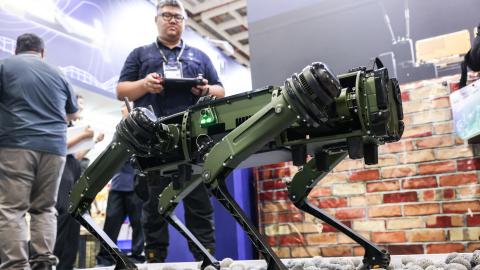

Join Senior Fellow Nadia Schadlow and an expert panel for a discussion on the DoW’s financial tools, the extent of the department’s authorities, and the role it will play in the broader American reindustrialization effort.








